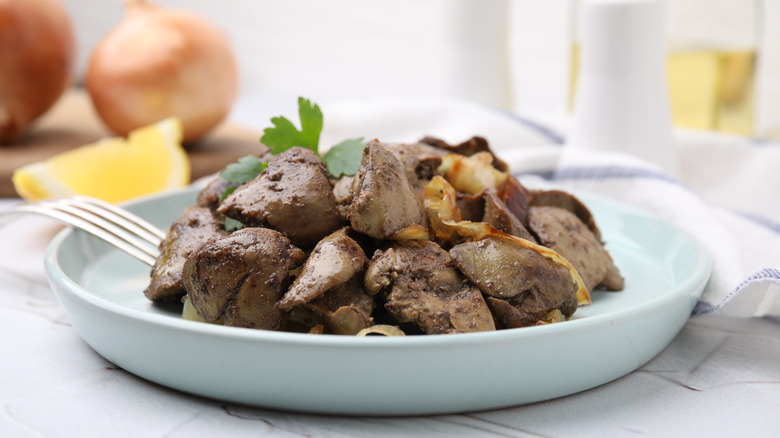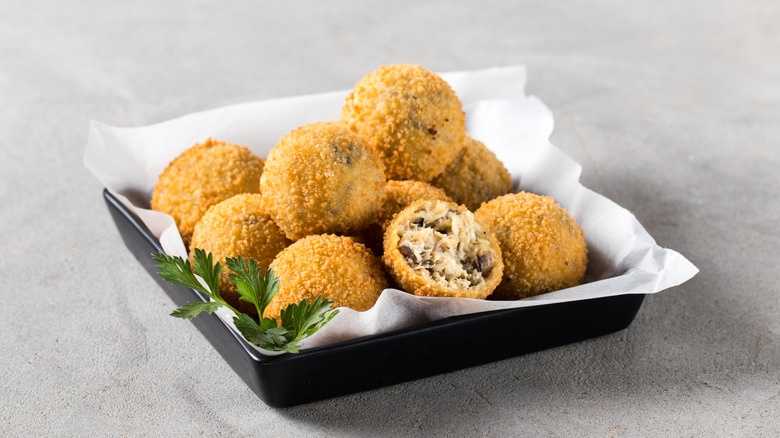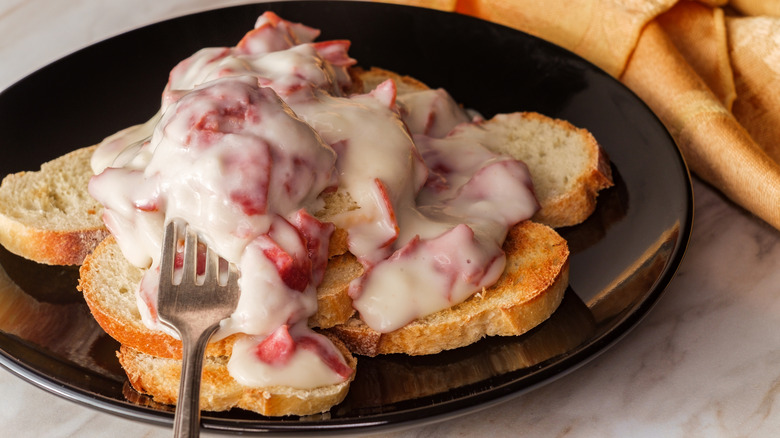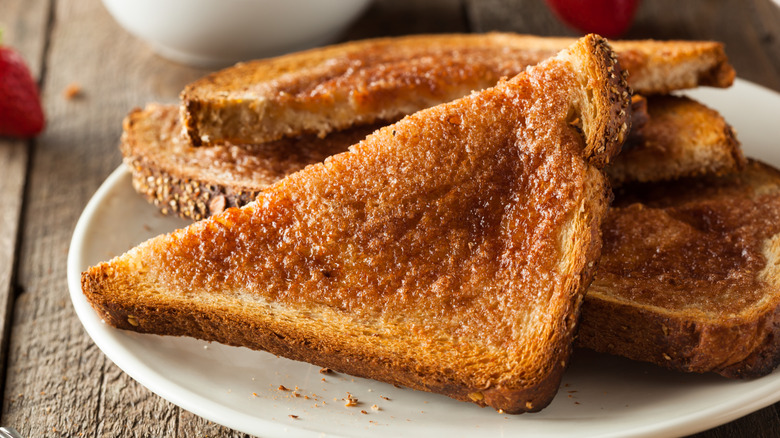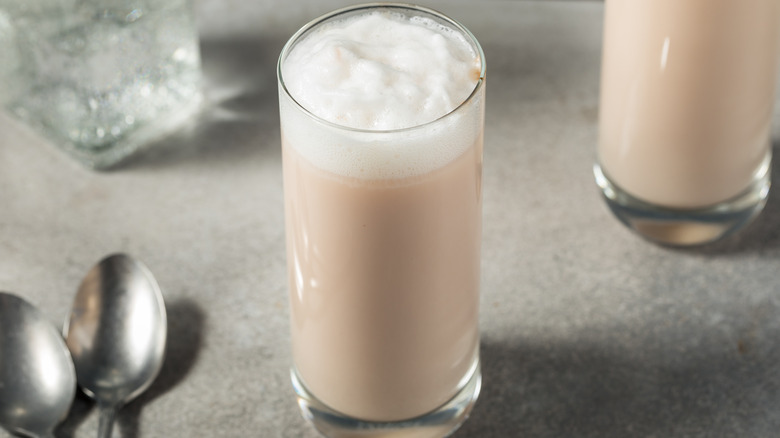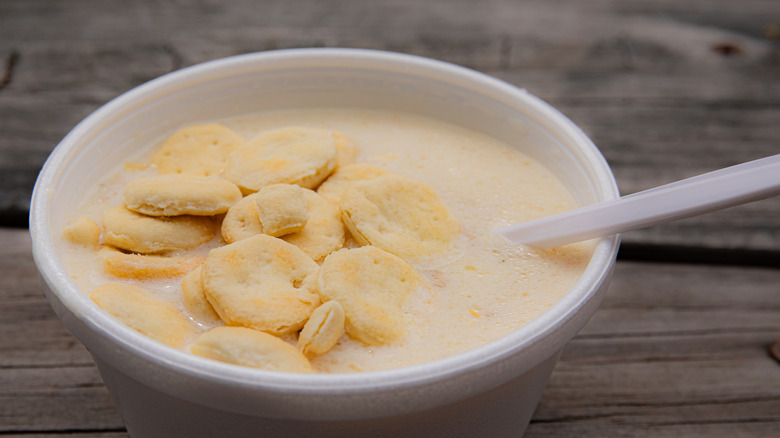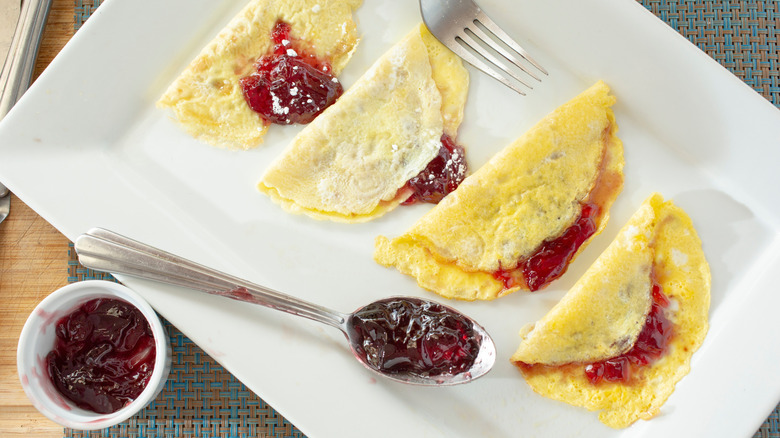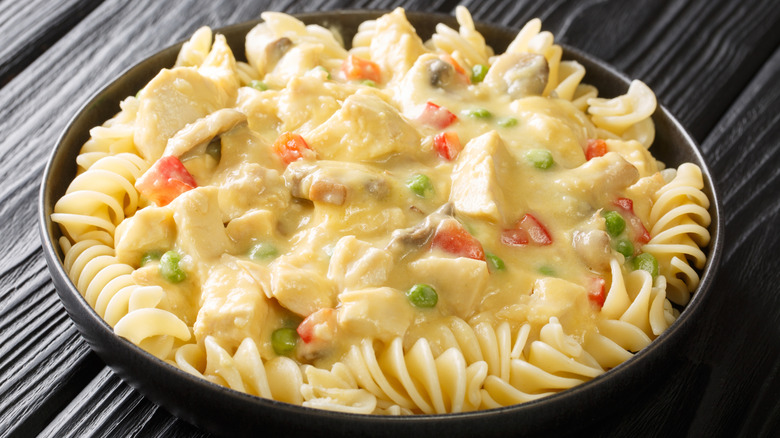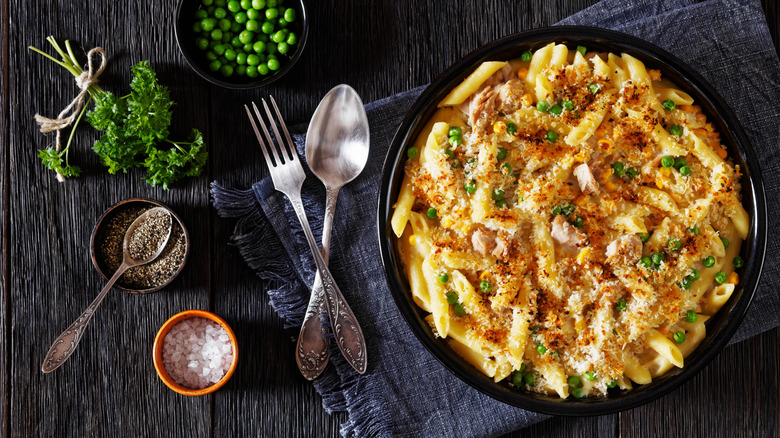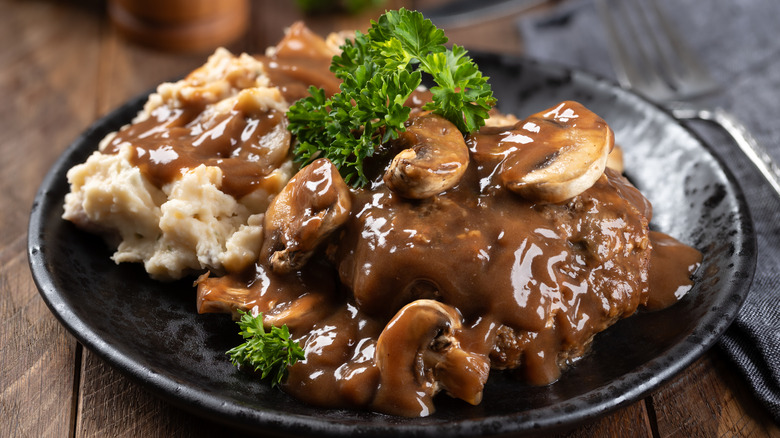Old-School Diner Foods That Are Nearly Impossible To Find Today
Diners are an unmistakable part of American food culture, where you can get cheap coffee and homestyle meals at practically any time of night or day. Across the 20th century, diners were the spot for workers, families, and all kinds of ordinary folk to get affordable, straightforward meals. They reflected tastes of the time, but these days, there are some old-school diner foods that you rarely see anymore.
Look at a diner menu from the '50s and you'll see familiar dishes like burgers, eggs, and pancakes. But as food trends shifted, many items that once felt essential to the diner menu have drifted into obscurity. What people loved in the 1950s and 1960s later seemed fussy, old-fashioned, or not aligned with modern preferences.
We're interested in the history of those diner dishes that were once common but are now nearly impossible to find regularly. These plates were not haute cuisine; they were pragmatic and made for price and volume. Whether you're nostalgic for your favorite diner meals of yore or just fascinated by food history, you're in the right place. Here are 11 old-school diner foods that are rarely found on menus today.
Liver and onions
Liver and onions used to be a diner staple, but now it's a once-popular food people don't eat much anymore. The dish pairs quickly pan-seared slices of beef or calf liver with sweet, soft caramelized onions. In mid-century America, it often appeared on short-order menus because liver was inexpensive, nutrient-dense, and could be cooked quickly without much fuss. Many regulars regarded it as a hearty, old-fashioned comfort meal.
Liver has long featured in European home cooking, so it may be that immigrants to the United States brought it over with them. There was a time when it was a popular meal in American homes, so by extension, it was found in diners everywhere. However, the texture and metallic tang of the dish made it polarizing. Some people loved its richness, while others found it an acquired taste.
Over the last few decades, liver has slipped from mainstream diner menus. Growing squeamishness about organ meats and a broad move toward milder proteins nudged diner owners to simplify offerings. Burgers, grilled chicken, and breakfast-for-dinner items proved safer bets. They were easier to sell and less likely to divide customers. Today, liver and onions is a rare sight on most contemporary diner menus. Maybe you'll find it on the odd rural mom-and-pop diner menu that hasn't changed in 60 years, but it's largely a dish of the past.
Turkey croquettes
Turkey croquettes were once a comforting staple in many diners. They were an economical way to transform leftovers or bulk-cooked poultry into a fried favorite. A classic croquette combines chopped or shredded cooked turkey with other ingredients to bind it. The mixture is shaped into patties or cylinders, breaded, and fried until golden. Chicken croquettes were an alternative that some diners favored.
These croquettes would have been particularly popular in eras when resourcefulness was prized. During wartime and the postwar decades, cooks celebrated techniques that stretched meat further. By taking potentially bland meat, then breading and frying it, it was a surefire way to make it more delicious. We can see why turkey croquettes were popular in diners, but what's less clear is why they fell out of favor. Perhaps palates shifted away from these kinds of filling meals and toward simpler items like burgers and hot dogs. It could also be that turkey became less popular outside of Thanksgiving dinner, and that's what put people off.
For those who recall them, there's a lot of nostalgia surrounding turkey croquettes. Though uncommon now, they would be easy to modernize and welcome back on a diner menu. In fact, you should already be turning your leftovers into croquettes at home. We bet with the right kind of upgrade, they'd be a popular diner meal once more.
Chipped beef on toast
Chipped beef on toast — often known by its less formal nickname, "S.O.S." — was once a fixture at diners across the United States. The dish consists of thin slices of dried, salted beef served in a creamy white sauce on toast. It originated as a practical, filling meal for the U.S. military in the early 20th century, as it was inexpensive, protein-rich, and easy to prepare in large batches. When veterans returned home, the dish naturally made its way onto diner menus, where it remained a nostalgic favorite for decades.
By the mid-20th century, chipped beef on toast was a go-to comfort food, serving as a hearty breakfast or quick lunch for diner patrons. But as tastes changed, chipped beef began to fade from everyday dining. Its heavy reliance on processed, shelf-stable meat seemed old-fashioned at a time when fresh ingredients and lighter fare became more desirable.
Today, it's rarely seen on diner menus. It's considered old-fashioned and the kind of meal your grandparents might have eaten rather than something you'd want to chow down on today. Though it may not grace modern diner menus as it once did, it's an interesting look back on how something like military service can influence tastes for a generation.
Cinnamon toast
Before diners became known for stacks of pancakes and extravagant milkshakes, one of the simplest pleasures you could order was cinnamon toast. This unassuming treat was made by buttering bread, sprinkling it with cinnamon sugar, and then toasting it to caramelize the sugar. Warm, sweet, and inexpensive, cinnamon toast was a diner staple in the early- to mid-20th century.
It was a common homemade comfort food in American households during the late 19th and early 20th centuries, and diners, always quick to adopt what people loved at home, put it on their menus. Children adored it and adults may have found it nostalgic. It tended to be more affordable and less overtly sweet than similar alternatives.
But, over time, it was overshadowed by flashier diner fare. French toast, pancakes, and waffles were more indulgent and took more time to make at home, so people were more likely to order them when eating at diners. Plus, the rise of commercial pastries made sweet breakfast items more varied. As menus expanded and competition grew, cinnamon toast quietly disappeared. Nowadays, it's rare to see cinnamon toast listed at a diner, though many people still make it at home. It might not be as exciting as some dishes, but it's beloved for a reason.
Egg creams
Despite its name, an egg cream contains neither eggs nor cream. So, what is an egg cream and what does it taste like? This classic soda fountain drink, once a staple in diners, is made with just three ingredients: cold milk, fizzy seltzer, and a generous pour of chocolate syrup. It's chocolatey and creamy with a crispness from the seltzer. Whipped together in the glass, the drink develops a frothy head that gives it its cream-like appearance. This explains the cream part of the name, but we're not quite sure about the egg.
Egg creams come from New York City, particularly from its Jewish immigrant communities. For what looks like chocolate milk, it's surprisingly light, refreshing, and not overly sweet. It's unclear exactly when or by whom this drink was invented, but it was likely in the late 1800s or early 1900s. Diners across the city quickly embraced it, before it spread far and wide.
Over the years, though, the drink became less popular. People either went for a fizzy soda or a milkshake, rather than a creamy sparkling beverage. Today, egg creams are still cherished in New York, where you can find them in a handful of old-school diners, delis, and soda shops. But even in the big city, they're hard to find. And outside of New York, it's nearly impossible to get an egg cream. They may be somewhat of an acquired taste, but we still think there's room on the diner scene for a wider range of drinks.
Rice pudding
When you think of diner desserts, pie is probably at the front of your mind. But, there was a time when rice pudding could be found on every self-respecting diner's menu. It was the kind of sweet treat that felt homey and comforting, and isn't that what diner menus are all about? To younger people today, it might seem like an odd addition. Too boring and old-fashioned. But there was a time when it was a hugely popular choice.
In the mid-20th century, when diners were at their cultural peak, rice pudding was a natural ending to a hearty meal of meatloaf, fried chicken, or burgers and fries. It wasn't flashy, but it was filling and affordable. Diner-style rice pudding was usually baked, giving it a denser, heartier texture. The top was covered in nutmeg or cinnamon before baking, infusing extra flavor.
These days, rice pudding has largely vanished from diner menus. It hasn't disappeared entirely; some retro-style spots still keep it alive. But it has been overshadowed by more modern desserts. Cakes, pies, and elaborate sundaes took over as diners leaned into items that felt more indulgent. Rice pudding started to feel like a retro dessert that people didn't necessarily want to pay for at the end of their meal.
Oyster stew
Oysters may not sound like classic diner fare today, but for much of the 20th century, oyster stew was just that. There were regional variations of oyster stew, so what was available locally varied. In New England, for instance, it was a simple dish of fresh oysters, butter, milk or cream, and a touch of seasoning. In the Southern states, it tended to have more ingredients, like onions, celery, and cayenne pepper. It was especially popular in coastal regions where oysters were abundant, but even inland diners served it thanks to canned oysters.
It might sound like a fancy dish for a diner, but oysters were inexpensive and plentiful in the 19th and early 20th centuries. This meant they were cheap enough for everyday people to enjoy. By the time diners were thriving in the mid-1900s, oyster stew was a classic that could be found on most menus.
But as oyster populations dwindled and prices rose, the dish lost its place on the standard diner menu. Changing tastes also played a role. These days, most people go to diners for pancakes, burgers, fries, and milkshakes rather than a seafood stew. You'll likely find oyster stew in seafood restaurants, but in diners, it has basically disappeared.
Jelly omelet
Few dishes better capture the quirky, anything-goes spirit of old diners than the jelly omelet. This dish is exactly what it sounds like: a classic folded omelet filled with fruit jelly. Sweet-salty combinations are trendy today, but this eggy-fruity combo takes it to another level. We're not sure if contemporary folks are ready to bring this back, but we'd sure give it a whirl. It sounds like a niche dish, but it was found on many diner menus in the early and mid-20th century.
This dish seems to have shown up around the later 19th century and was featured in "The Boston Cooking School Cook Book," which came out in 1896. So, it wasn't just a diner invention, but likely something people regularly ate at home. It makes sense, in a way. A plain omelet isn't inherently savory on its own; it's quite neutral, so it's not all that different from eating jelly with bread and butter. It's also a more protein-rich version of eating pancakes with jelly. It makes sense as a breakfast food, especially for those who like sweet breakfasts but don't want to be running on sugar and starch until lunch.
By the 1960s and 70s, however, the jelly omelet had begun to feel outdated. Tastes changed, leaving little room for something as old-fashioned as eggs with jam. Today, it's almost unheard of outside of vintage cookbooks or nostalgic food writing. While the jelly omelet might strike modern diners as strange, we wouldn't write it off just yet.
Chicken à la King
Chicken à la King was once a diner favorite. The dish featured diced chicken in a rich white sauce with veggies like mushrooms, peppers, and peas served on biscuits, rice, toast, or noodles. There was a time when it was considered a fancy meal, but it trickled down to becoming the kind of fare you could find in an average diner.
Its origin is debated, with some crediting chefs in New York City hotels and others linking it to Philadelphia or England. Wherever it began, diners were quick to adopt it as an affordable indulgence. It was filling, adaptable, and felt a little more special than some everyday diner meals.
By the time the 1980s rolled around, it started to feel outdated, and it wasn't classic enough to keep its spot among those kinds of diner dishes that never go out of fashion. Right now, you'd be hard-pressed to find it at your local diner. Some people might miss this old favorite, while others consider it no big loss.
Tuna casserole
Few dishes speak to the mid-20th-century diner era quite like tuna casserole. A typical version combined noodles, tuna, and cream of mushroom soup, often finished with a crunchy topping of breadcrumbs, crushed potato chips, or crackers. It was found on diner menus everywhere, sometimes as a blue plate special, but now it's rarely seen.
Diners embraced it because it fit neatly into the category of homestyle cooking that these kinds of establishments specialized in. Back then, people often came to diners to get the type of food they enjoyed at home, when they were out of town or didn't want to cook. So, this kind of popular everyday meal was ideal.
Over time, however, things changed. By the 1980s and 1990s, diners were shifting toward burgers, club sandwiches, and fries as their core offerings, while tuna casserole started to feel like something best left to potlucks or family dinner tables. The reliance on canned ingredients also made the dish feel like a relic from the past, and not what people wanted to spend their hard-earned cash on. Today, tuna casserole has mostly disappeared from diner menus, though it lives on in family kitchens and retro cookbooks. It still has a place in many hearts as an iconic diner food, even if fans have to recreate it at home.
Salisbury steak
Depending on your age, you might only recognize Salisbury steak from TV dinners and school cafeterias, but it was once a diner mainstay. Named after Dr. James Salisbury, a 19th-century physician who promoted ground beef as a health food, the dish became especially popular in mid-century America. At diners, Salisbury steak was usually made from scratch out of hamburger meat shaped to resemble a steak, and served with brown gravy, mashed potatoes, and vegetables.
During the 1940s through the 1960s, it fit right into the diner ethos. It was hearty, inexpensive, satisfying, and reminiscent of home cooking. It may have been seen as a slightly more elevated alternative to a hamburger, while still being affordable compared to an actual steak dinner. Covered in gravy, it's a great meal regardless of whether or not it's gourmet.
But over time, Salisbury steak gained a reputation for being old-fashioned. Its association with frozen dinners and cafeteria trays in the latter half of the 20th century didn't help its standing. While it never fully vanished, you'll rarely find it on diner menus. For the most part, it has been replaced by burgers, chicken-fried steak, or meatloaf as the go-to beef options at diners. So, anyone looking for a classic Salisbury steak may be out of luck.

